Just past the halfway point, 2023 has already been a remarkably turbulent and transformative year in marketing technology. Cloud providers continue to proliferate — the Chiefmartech 2023 Marketing Technology Landscape Supergraphic now contains 11,038 solutions. Thats an 11% increase from 2022, and an exponential rise from ~350 providers a decade ago.
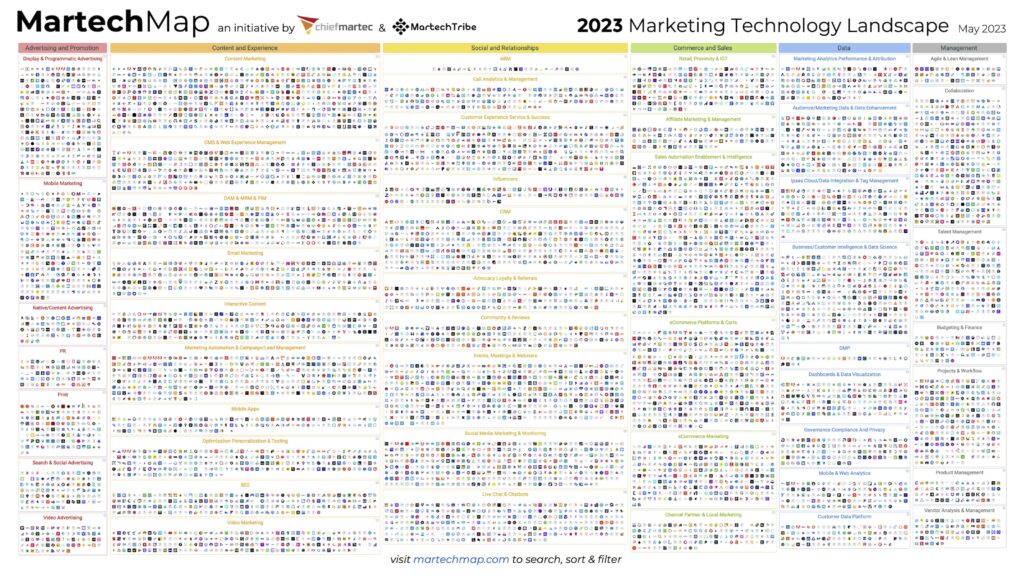
On top of this relentless growth, the category as a whole is now rapidly scrambling to adopt natural language and AI functionality powered by large language model (LLM) tools, particularly OpenAI’s GPT.
Hubspot got the ball rolling at the beginning of March, with the public alpha launch of chatspot.ai, a “chat UX” reinvention of Hubspot’s interface (“built with ♥️ and GPT-4”). In April, at Microsoft’s roadmap demo at the Nonprofit Technology Conference, senior product manager Alex Kasavin proclaimed, “A.I. has been coming for decades, and suddenly A.I. is here overnight,” then proceeded to walk through how Microsoft will be incorporating GPT features into its entire suite of familiar products. The Salesforce World Tour, which swung through New York on May 4, was a cascade of demos of GPT integrations across its platforms. With breathtaking velocity, even the most established tools we use in our daily work are likely to evolve this year to feature natural language processing and generative AI. Few currently understand the utility of these product reinventions and the value is yet to be proven, but the industry is on notice that changes are coming quickly.
Against this backdrop, we are particularly interested in the implications for nonprofit organizations, the community we work with at Blue State. To learn more about this, we conducted a survey to ask nonprofits how they are planning their technology roadmap and what challenges they are seeking to solve. We ran the survey between February and May this year. We invited around 300 organizations, and 58 responded.
We presented the results at Drupalcon Pittsburgh in June, and have summarized key findings here.
More tools brings challenges managing complexity and data fragmentation
Nonprofits generally work with multiple specialized cloud tools, many of which are built for purpose for the nonprofit sector. Here you can see the core marketing tools Blue State clients typically run.
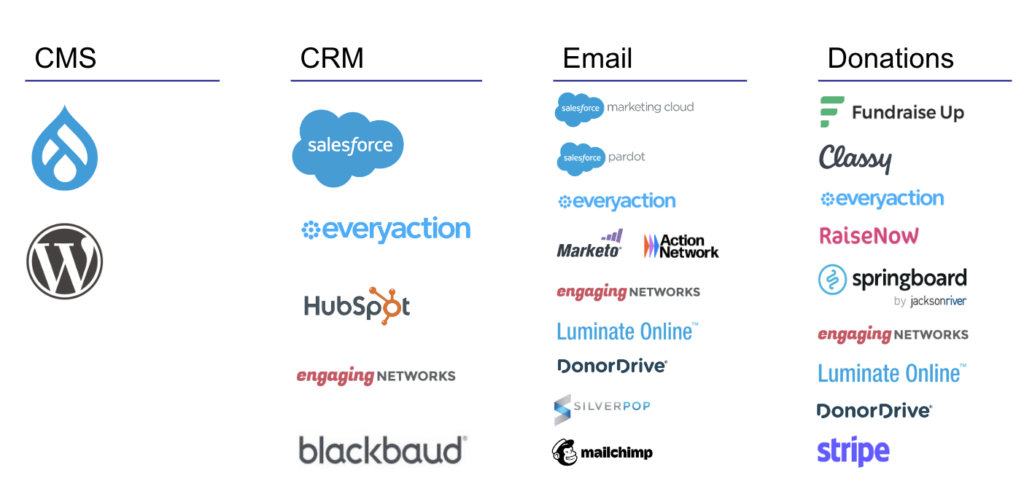
Website, CRM, email, and donation processing are functions that most nonprofits have in common. Blue State most often delivers websites in WordPress and Drupal, so those are the two we’ve focused on in our research to better understand the needs of our clients, but there are certainly several other CMS solutions used by nonprofits as well.
For managing engagement outside of the site, some organizations use a single, built-for-purpose platform that handles segmentation, email, and donations, tools like Blackbaud, EveryAction, Engaging Networks, Action Network, or Neon. Other orgs, if they have the resources, are taking the composable stack approach, with separate tools for CRM, email, and donations. Salesforce has been the key driver of this trend. The net result is that nonprofit organizations today are running digital communications and campaigns with a tailored combination of tools.
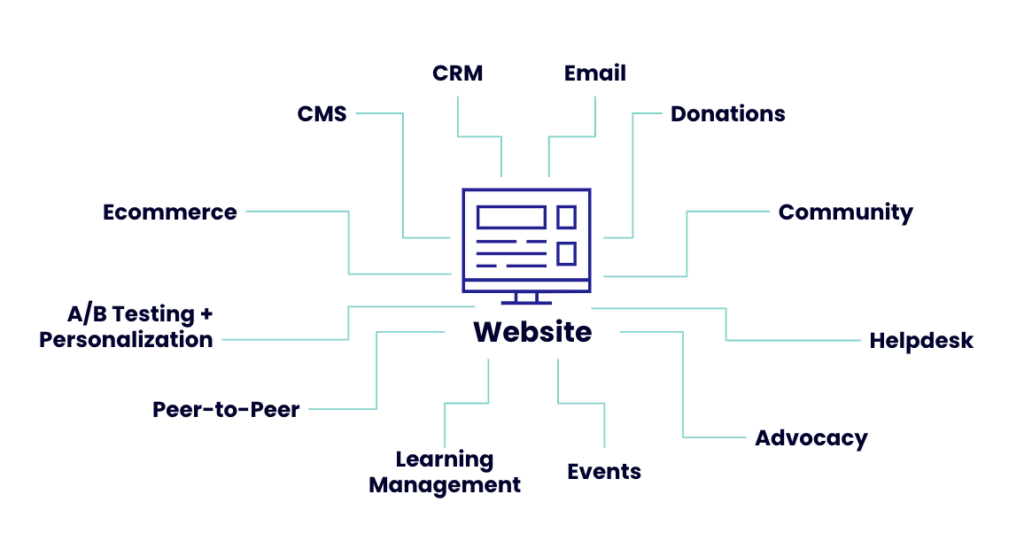
If we zoom out a bit, we see that the picture for digital engagement is even more complex.
Depending on the mission of the organization, there are typically a few other important tools in the digital stack. An organization may be mobilizing supporters for political causes with specialized tools for that work. For many nonprofits, in-person events or peer-to-peer fundraising are an important focus. An organization may manage grants, support an online community or offer online courses. And organizations are also bringing in new tools that can support their work, which might include A/B testing, personalization, machine learning, data warehousing – the list goes on.
So while very few organizations are doing all of these things, we typically work with nonprofits that are running between 5 to 7 important cloud platforms. Here is a snapshot from our survey of the various systems commonly used by nonprofits to create their web-facing experience.
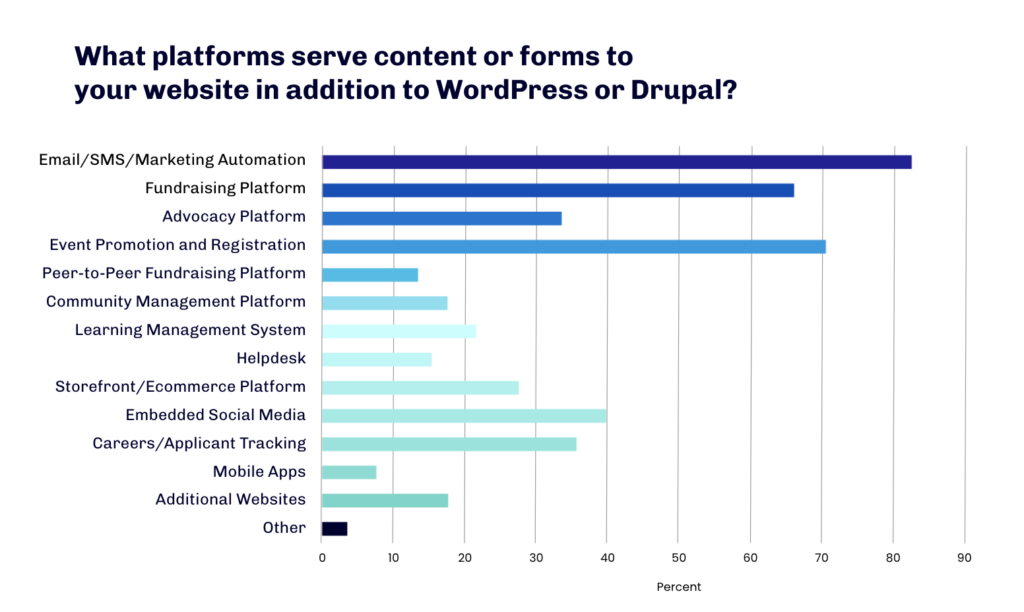
What we are seeing here is that to make what a supporter experiences as a single journey, the staff who manage the experience need to create content in several separate systems. Each of these systems will come with different requirements to coordinate sessions, authenticate users, and measure engagement and conversions. Working with multiple specialized marketing tools creates a new challenge to manage data fragmentation on the back end.
We are frequently hearing from our clients these days that their systems aren’t talking to each other and there is data integration work that needs to be done to make the platform, as a whole, as effective as it could be. Our survey confirmed this trend.
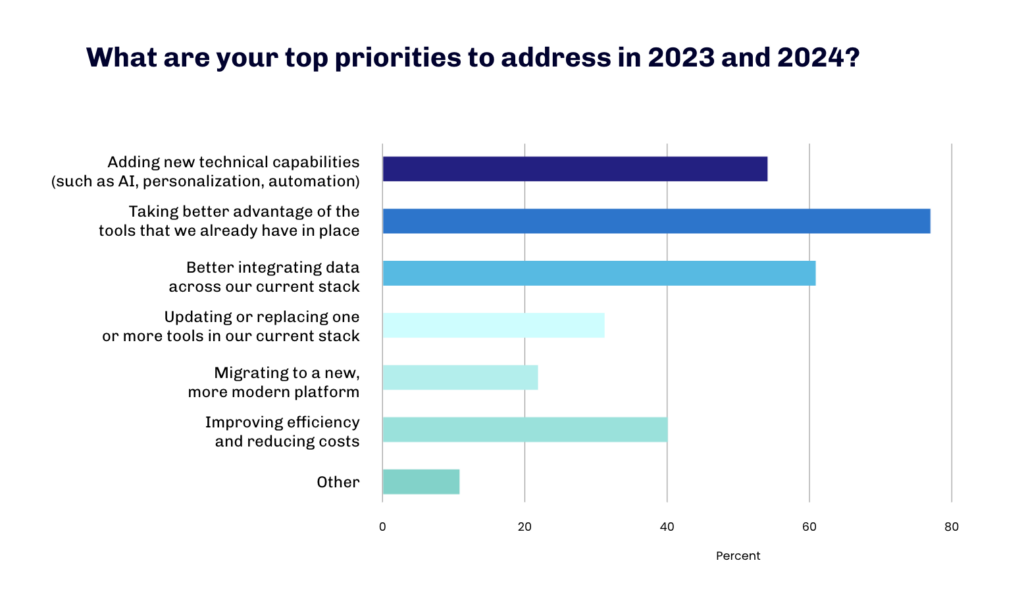
Our survey shows two common concerns that are driving investment in the coming year: Taking better advantage of the tools that are already in place, and Better integration of data across the current stack.
The first point reinforces something we hear from many clients, that they know they could be doing more with the features and capabilities of their current systems but their team resources are stretched too thin to make use of the more advanced capabilities. Sometimes it’s also an issue with the tools – the platform may have the capability to run a program with sophisticated segmentation and personalization, but it is just too difficult to learn and too time consuming to be practical. This mirrors findings in the Salesforce Global Fifth Edition Nonprofit Trends Report:
The most commonly cited barriers to digital transformation are a lack of budget or resources (37%) and higher priorities within the organization (30%). Other challenges include a lack of skilled talent to implement and manage technologies (28%) and a lack of understanding of those technologies (26%).
The second point – addressing data fragmentation – is an area receiving a lot of focus among our clients now, with data warehousing, CDPs and AI all receiving interest to solve these issues.
Together, these indicate that many teams feel the right tools are in place, but they have a hard time making these tools work in a unified fashion. Ultimately, figuring out how to get these tools talking to each other gives organizations a deeper understanding of their supporters and can help segment and personalize marketing campaigns, website experiences and theoverall journey for your supporters.
Reduced revenue brings competition between tools for investment
2022 year end saw revenue decline across nonprofits’ digital programs. A year-long trend of lower gift volume (about -5%) continued amidst economic concerns. Less revenue combined with more digital marketing tools means organizations are making tough choices between platforms for attention and investments. We asked respondents how priorities are changing across a range of tools and capabilities.
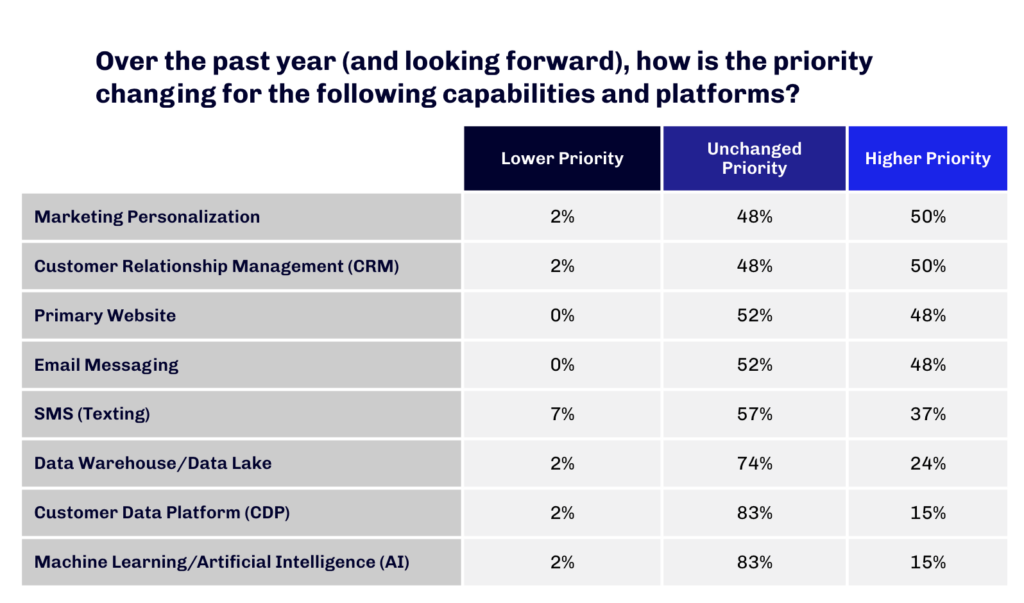
We can see here in the top right that there are four that stand out as increasing in priority:
- Marketing personalization
- The primary website
- CRM
Typically in the nonprofits we work with we see tighter integration maturity between the CRM and email tools to create marketing personalization, and relatively little integration for personalization between the CRM and the website CMS. This sets up a 3-on-1 competition among these four priorities because more progress can be made faster between the CRM and email.
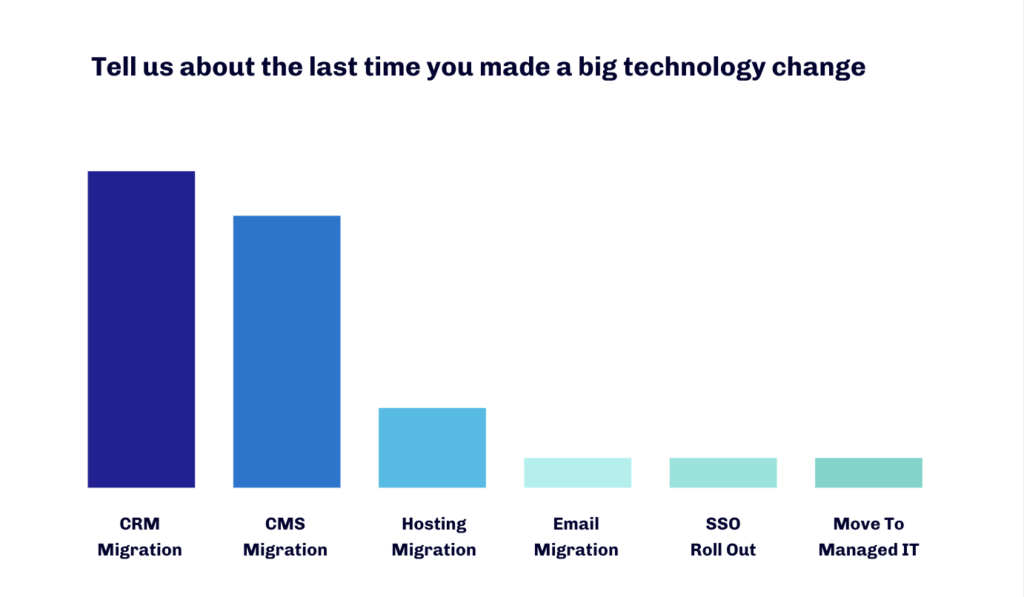
We also asked respondents to look back to their most recent big technology initiative and investment. The majority said the most recent big move was a move to a new CRM. They often added comments that it was a long and bumpy road where deadlines kept getting pushed back because of how many areas of the organization it impacted.
Many organizations also reported that they recently updated their website. However in half of the cases reported so far this was more of a required, major-version CMS upgrade rather than a strategic choice.
Overall, our impression is that when organizations take on a change to the CRM when it is seen as a strategic imperative, and once started, it becomes a consuming priority for several years. Conversely – or, perhaps because of prioritized investments in the CRM – organizations are currently making big changes to the website less frequently. When they do make a major investment in the website, it is often not driven by strategy but in reaction to technical debt.
Put another way, organizations may know that their website could be improved, but they choose to just get by with what they have because upgrades to the CRM are seen as more crucial.
Following a CRM migration, an organization’s need to better integrate data across systems may come into sharper focus, driving a new set of priorities in that direction.
The case for investing in the website
So we’ve talked so far about how the survey suggests the website has been losing ground in competition for investment with other tools in the stack. We’ll close by turning back to look at what the survey revealed about the challenges and opportunities for the website.
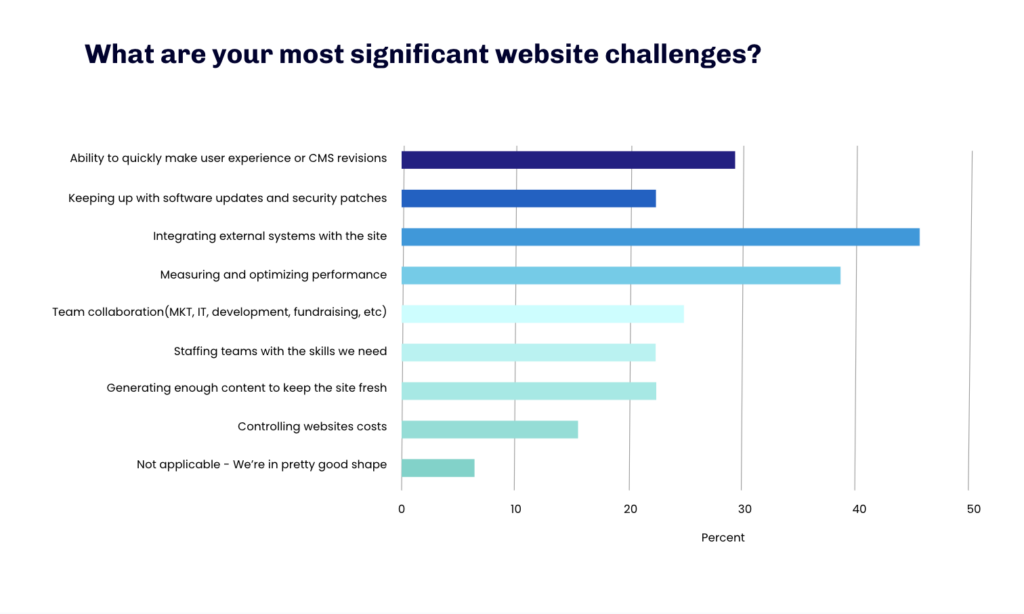
We asked respondents “what are your most significant website challenges?” The two most common responses were integrating external systems with the site and measuring and optimizing performance.
This resonates with what we heard about making systems work well together. It’s a priority to incorporate the website into the broader martech stack to unlock capabilities like website personalization and behavioral data collection. We hear from clients that they are eager to get more sophisticated in how websites engage visitors, if they could only get the various data systems working well together to enable it.
Despite those challenges, we have seen recently that the website has been outperforming other channels like email, particularly for fundraising. Overall, 2022 was a down year for fundraising, which shouldn’t be surprising given overall concerns about the economy and waves of layoffs at the end of the year. 2022 end of year results saw an overall revenue decline, about -5%. Email contributed most significantly to this shortfall, sagging by about -15%.
However, while revenue was lower generally, more than half of our clients saw increases in revenue attributed solely to the website, meaning supporters finding the site organically, not driven from a media buy, email or social, coming in through the front door, getting inspired and deciding to make a donation.
So making improvements to the website to optimize these journeys can produce meaningful results. In our work with clients, we’ve been focusing more efforts on SEO, A/B testing and conversion rate optimization. Improving mobile journeys in particular is an area where gains can be made. On average, close to 60% of all traffic is from mobile, but less than 40% of donations are from mobile, and the average donation is half compared to desktop. Digging in to optimize the donor journey on mobile is a real opportunity to move the needle.
So while we recognize the practical challenges organizations face as they seek to incorporate new tools and unify their data, we’re encouraged that the survey confirmed that a majority of organizations still see the website as their most important asset for marketing and engagement.
And for half of them, the website is only increasing in priority.
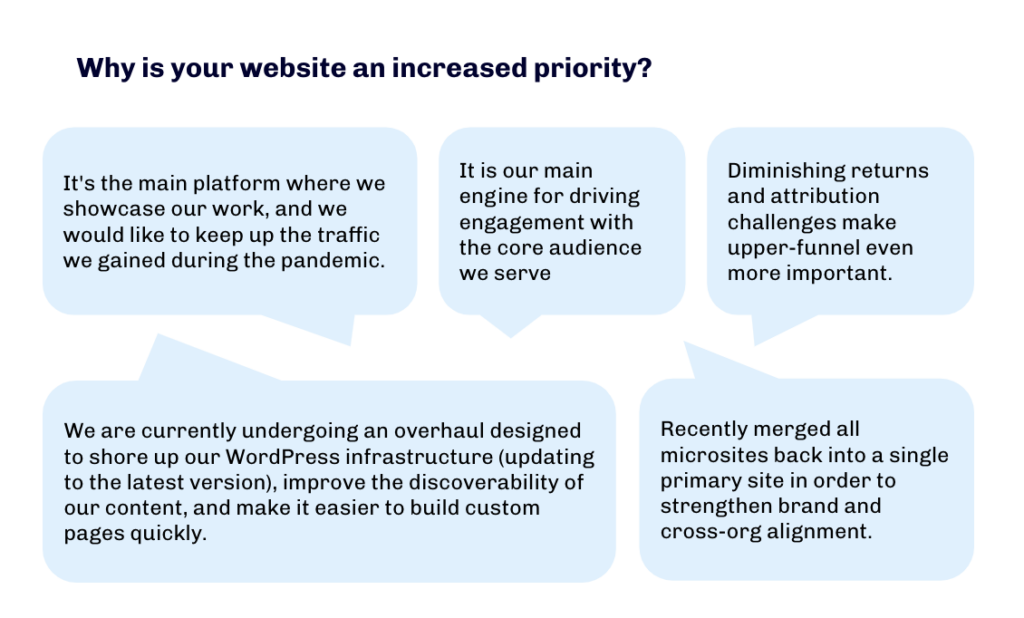
To end, we’ll share advice we’ve been giving our nonprofit clients for how to maximize their limited time and budget.
- Don’t think about updates to the website in terms of a 3- or 5-year cycle of major rebuilds. Shift to thinking about frequent, incremental improvements.
- Think about the website as a revenue-generating digital product with an ongoing roadmap. If your org has recently done a major website redesign or upgrade, it’s likely that the site is in good shape for incremental work. That will give you the flexibility to focus on whatever is the most pressing issue of the moment, whether it be core web vitals performance, SEO, the mobile user experience, or even adding in some level of personalization as the rest of the stack catches up.
It’s not revolutionary, but it’s also not how most of our clients work. For those who have made the transition, we’re able to be a lot more agile and make more consistent progress.
Thanks to these partners who helped recruit survey participants: Kanopi Studios, Forum One, Kalamuna, ThinkShout, WDG, Capellic, Cornershop Creative, and Pantheon.